We love hearing how our Bibles are bringing people closer to God. When we came across this writer and podcaster’s posts about The Wayfinding Bible, we were so excited. Wendy has graciously agreed to share why she loves this Bible and how it has helped her and her family go deeper into God’s Word. Thanks, Wendy! You can follow her on Instagram, Facebook, and Twitter (@mrswendyjolson)
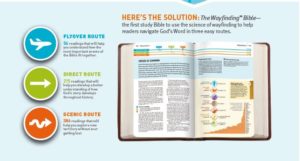
By Wendy J. Olson
I might be an awful person: I judge a book by its cover.
No, literally. When I buy a book, I decide if I will like it based on what the cover looks like. I’ve literally not read a great recommendation because I thought the cover was weird. It gave me the creeps. I’m usually spot on about these things too. Good cover, good book. I believe my logic to be sound.
So when I went in search of a new Bible several years back, I did just that. I looked at all the Bibles, compared covers, and made my decision based around some guidelines. First and foremost, I wanted a leather-bound Bible. It had to be wiggly—nothing is worse than a stiff Bible. I also wanted something I could actually read and write in the margins. I’m a big doodler. I like to take notes and even write the date in the margins of when I learned something. Sometimes I will even write where I heard it or who I heard it from. From year to year it helps me see what I’ve learned and how my faith is being shaped and is evolving.
Several hours on the floor of a Lifeway and mild mumblings to myself later, I finally settled on The Wayfinding Bible. Not only did I find the format to be most useful for my taste, but I liked that it had different “read-through” options. I should probably note here that I have never actually done any of these reading plans, but I still like having the options.
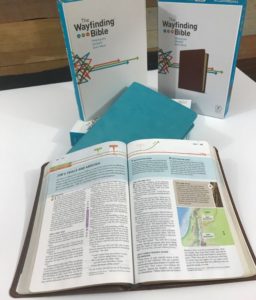
I don’t know about you guys, but I’ve always been the person scratching my head when someone says, “The Bible is clear.” Maybe I’m the only one, but the Bible has never been so black and white to me. I’ve noticed the more I read, the more I dig in and learn and feed my spiritual beast, the more perplexed I can find myself. Sometimes I just need plain English! This is the exact reason I purchased an NLT version. I was brought up in a small Southern Baptist church where nothing but NIV and NKJV were acceptable. God love ’em. It wasn’t until I heard my good friend speak and read from her NLT version that I was like, “Yessss! I need me some of that!”
Not only is The Wayfinding Bible in the New Living Translation, but it also has excerpts every few pages that go into more detail about what the Bible is saying, which I love. There is a brief description about the part of the story they are talking about; then an Observation Point, which gives a little bit of history and background for you; and finally an Exploration Point, which gives you further insight and maybe even poses a question for you to ponder. This is one of my favorite features of The Wayfinding Bible because it really brings everything around full circle. My kids like reading these parts, and when I’m stumped on how to explain something so they might understand better, this gets me out of a jam.
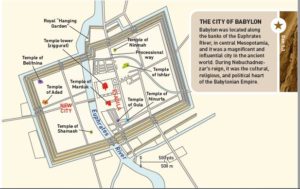
The Wayfinding Bible’s pages contain maps and historical references, including what it looks like there now, with geographical explanations of “where in the world” and pictures to help you visualize where you are in the story. They call these “Historical Markers” and mark them with stars throughout the text, and “Scenic Overlooks” are marked with binoculars.
Each book of the Bible contains “Book Introductions,” giving you the background and timeframe of the book, other events that happened surrounding the writing of the book, and a note about “Finding Jesus in . . .” each book. Book Introductions also map out the three “flight,” or reading, plans throughout each book of the Bible. I’ve learned a lot for myself with this feature. I love a little bit of history, but not too much, and figuring out what is happening when and where and to whom around the writing of each book. At the bottom of each Book Introduction is a timeline, showing you the year and, in the Old Testament, how far away you are from the birth of Jesus or, in the New Testament, how far removed you are from his birth Sometimes we get lost in the logistics and shuffle in the Word and forget that the Bible isn’t written in chronological order. This helps recalibrate us and gives us a better sense of what each book means and what it meant to its readers over time. Eight times in The Wayfinding Bible you’ll find a “Getting Your Bearings” section where you can stop and get caught up on some history and geography as well as read some background stories that help tie it all together.
This may sound silly, but my two favorite things about this Bible are the layout and the fact that I can HIGHLIGHT in it!!! What!?!?! For years I was stuck with a Bible that was printed on such thin paper that I could spit through it or tear it so easily if my pencil was too sharp. The Wayfinding Bible is not such a Bible. This probably doesn’t seem like a big deal to most people, but to those of us who are serious about our studying and scouring and highlighting and . . . doodling, this is key! I have had this Bible for over four years now, and it has taken all I have handed it. Plainly, it has taken a beating. And it has survived, flawlessly.
And as for the layout, I like a Bible I can actually read, because I do . . . actually read it. I don’t like small print or weird margins or layouts. Nonetheless, I love the friendly layout of The Wayfinding Bible. It is friendly for my eyes and for my brain, and I need both of those to get along in order for me to comprehend anything.
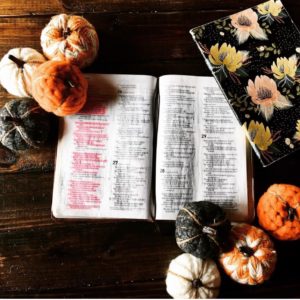
So there it is, my favorite Bible thus far. Anytime I post a pic of my Bible, the internet goes crazy. People are craving something more friendly and useful because they are WANTING to read their Bibles, and this one delivers on all counts. I love it; my kids love it. If my house were to ever catch on fire, God forbid, I would grab my kids and my Bible. I read a post by a famous Christian speaker who said she packed her Bible in her checked baggage and it almost got lost. She said it felt like she had lost her child, and I know the feeling. If I lost this one, I would be heartbroken.
“If Found, Please Return and Reward WILL Be Given!”
I don’t think I’ve ever been attached to a Bible like this before, and I don’t think I will ever again. This is it for me. The only way it could be better is if the NLT and The Message versions had a baby and birthed it in this Bible edition. Who do we talk to about that?
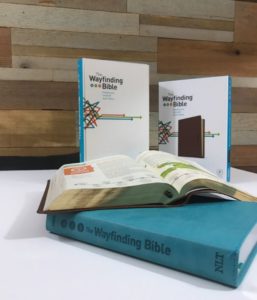














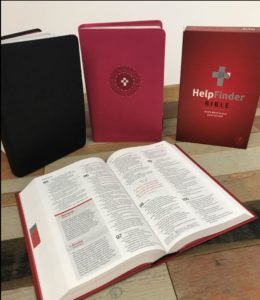















Recent Comments